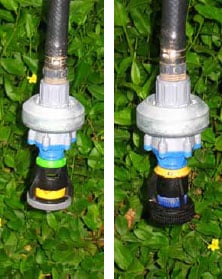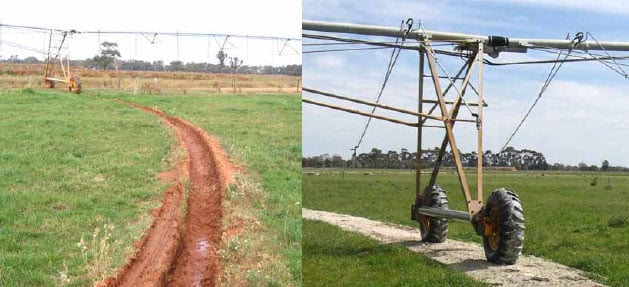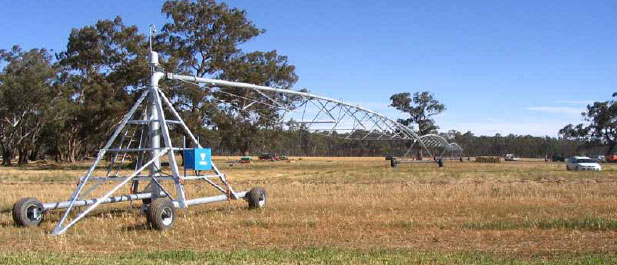System design can vary greatly for Centre Pivot or Lateral Move (CPLM) irrigation systems. Variations in design can have a large effect on capital and operating costs. Paddock shape, soil type, local climate, crops to be grown and power source will all influence design requirements. Understanding these design requirements for your selected site will enable you to compare quotes from different suppliers and ensure you get a machine that meets your needs.
System Capacity
This is the most important design criterion for CPLM systems. The system capacity of a Centre Pivot is the rate at which water can be supplied to the irrigated area, expressed in millimetres per day (mm/d). This is typically between 8 and 20 mm/d. It is the main criterion the pump, pipes and sprinkler design are based on, and for a given pivot can be calculated as follows:

For example, with a pump flow rate of 6 ML/day irrigating 50 ha, system capacity is 12 mm/d.
If the system capacity is too low or under-designed, the system may not be able to supply enough water over a hot spell when at peak crop water requirements. A conservative system capacity ensures irrigation requirements can be met comfortably, even under extreme climatic conditions. However, this will increase the investment costs (larger pipes, pumps and / or pressure).
The desired system capacity depends on the water requirement of your crop, the application efficiency of the irrigation system and the operating hours of the system. However, high system capacity can lead to high average application rates (AAR), especially on larger machines.
If AAR exceeds soil infiltration rate, runoff will occur, and can cause waterlogging in some areas while other areas are under watered. AAR can be reduced by selecting sprinklers with a large throw diameter and installing spreader bars.
Capital vs Operating costs
The selection of pipe sizes for the span-pipe and mainlines involves a compromise between the capital cost and the operating pressure. Operating pressure determines the ongoing operating costs, with higher operating pressure increasing pumping costs. See the next article in this series that describes the trade-off between capital and operating costs in detail.
Diesel or electric operation?
Electric power is generally preferable for convenience, ease of operation and lower operating costs, particularly if off-peak power can be utilised. However, Lateral Move systems that pump out of an open channel are generally powered by a diesel engine.
A main consideration in system power supply selection is the cost of connecting electricity to the pump site which can be a substantial cost.
Sprinkler packages

Moving plate (LEFT) Fixed plate (RIGHT)
There are a wide array of sprinklers and nozzles available. Sprinklers represent less than 7% of the total cost but are responsible for more than 70% of the irrigation performance. There are many varieties of sprinklers and nozzles available.
Fixed plate sprinklers are the simplest and cheapest. They have a relatively small throw and are suitable for pastures provided the sprinkler spacing along the span-pipe is close enough and the average application rate is not excessive.
Moving plate sprinklers have greater throws and produce a more uniform droplet size and a better distribution uniformity.
Talk with your suppliers to get the best outcomes for your requirements. Don’t skimp on sprinkler packages during design and purchase.
Replacement of older, poor performing sprinkler packages can provide a simple and cost effective performance improvement.
End-guns
End guns are often fitted to CPLM systems, especially Centre Pivots as a cheap way to increase the area covered. However, end guns normally apply less water than the rest of the system and have poorer uniformity. This can result in poor crop performance compared to the rest of the machine
Higher system pressure is required to operate an endgun and this results in higher operating costs. For example, an end-gun may need 45 psi (31 m head) where 20 psi (14m head) or less is needed for the sprinklers. This could cost an extra $16.15/ML or $4845/year on a 50 ha pivot pumping 6ML/ha/year (assumption: pump energy efficiency of 3.8 kW.hr/m and power cost $0.25/kW.hr)
The high velocity and large droplet size of water emitted from an endgun can also damage soil structure, reducing infiltration.
Newer sprinkler technology such as ‘end sprays’ and low-pressure end guns provide reasonable uniformity over 6-15 m of additional radius without the need for booster pumps and are cheaper to install.
If an end-gun is included, it should ideally be pressurised by a booster pump at the end of the pivot. End guns from the USA need 60hz, and therefore don’t perform well in Australia with a 50 Hz electricity supply.
Towable pivots
Most manufacturers offer towable pivot versions. This makes it possible to use one pivot structure to irrigate two or more circles. However, watering an additional circle effectively halves the system capacity of the machine. System capacity is further reduced by time taken to move the machine between circles which reduces the ‘pumping utilisation ratio’ (the time available to irrigate).
Autumn and spring irrigation of annual pastures and winter crops may be possible over multiple circles, however growing summer crops on multiple circles is generally not recommended.
Pumps
Pump selection is critical for correct performance. Operating speed, total dynamic head (or pressure), flow rate and impeller trim are some of the key parameters. Many cases of poor centre pivot performance are due to incorrect pump and pipeline matching.
Large lateral move systems require very high flow rates which requires extra focus on certain details. Extra care must also be taken on channel design and roads for the cart to travel on.
Wheel tracks
Bogging and/or wheel ruts can be a significant problem. New installations should be fitted with a “dry-wheel pack” (half-throw sprinklers on solid drops or boombacks) to keep water off the wheel track. To avoid the formation of wheel ruts, wheel tracks should be built up and compacted during installation of the system and regular maintenance performed to prevent water from ponding on the tracks.

1. a) Wheel rut damage & b) Wheel rut improvement
Content sources and further information
These are just some of the design factors of a CPLM machine. For more detail and for a design to suit your situation talk to a system designer.

